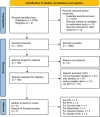PD-1/PD-L1 Inhibitors Plus Antiangiogenic Drugs Versus Sorafenib as the First Line Treatment for Advanced Hepatocellular Carcinoma: A Phase 3 RCTs Based Meta-Analysis
- PMID: 39665239
- PMCID: PMC11635864
- DOI: 10.1177/15330338241305700
PD-1/PD-L1 Inhibitors Plus Antiangiogenic Drugs Versus Sorafenib as the First Line Treatment for Advanced Hepatocellular Carcinoma: A Phase 3 RCTs Based Meta-Analysis
Abstract
Background: For advanced hepatocellular carcinoma (HCC), sorafenib remains the established therapy. PD-1/PD-L1 inhibitors plus antiangiogenic drugs (PIAD) as a new therapeutic approach for advanced HCC is still a subject of clinical debate regarding whether they offer improved treatment outcomes. This study was conducted to compare the two treatments in terms of antitumor efficacy and safety.
Methods: Randomized controlled trials (RCTs) comparing PIAD and sorafenib for advanced HCC were retrieved from six databases. Survival (overall survival [OS] and progression-free survival [PFS]) were the main outcomes measured. Secondary endpoints included responses, adverse events (AEs), and effects on quality of life.
Results: Seven studies based on four RCTs (CARES-310, COSMIC-312, IMbrave150, and ORIENT-32) were included. The PIAD group exhibited better OS (hazard ratio [HR]: 0.69, 95% confidence interval [CI]: [0.53, 0.89], P = 0.005), and PFS (HR: 0.60, 95% CI: [0.53, 0.67], P < 0.00001). The survival advantages of OS and PFS were confirmed in almost all subgroups. The PIAD group exhibited higher OS rates at 6-18 months and PFS rates at 6-12 months. Additionally, the objective response rate, disease control rate, complete response, and partial response were higher in PIAD group. The PIAD group had a delayed decline in quality of life, physical functioning, and role functioning. However, the PIAD group experienced more grades 3-5 and serious AEs, along with treatment discontinuation, dose reduction, and dose interruption.
Conclusions: PIAD appears to be better than sorafenib for advanced HCC with better survival and responses. However, its higher rate of AEs requires cautious attention.
Keywords: PD-1/PD-L1 inhibitors; antiangiogenic drugs; hepatocellular carcinoma; meta-analysis; sorafenib.
Conflict of interest statement
Declaration of Conflicting InterestsThe author(s) declared no potential conflicts of interest with respect to the research, authorship, and/or publication of this article.
Figures





Similar articles
-
Comparison of efficacy and safety of PD-1/PD-L1 combination therapy in first-line treatment of advanced NSCLC: an updated systematic review and network meta-analysis.Clin Transl Oncol. 2024 Oct;26(10):2488-2502. doi: 10.1007/s12094-024-03442-3. Epub 2024 Apr 16. Clin Transl Oncol. 2024. PMID: 38625495
-
Toripalimab plus bevacizumab versus sorafenib as first-line treatment for advanced hepatocellular carcinoma (HEPATORCH): a randomised, open-label, phase 3 trial.Lancet Gastroenterol Hepatol. 2025 Jul;10(7):658-670. doi: 10.1016/S2468-1253(25)00059-7. Epub 2025 May 20. Lancet Gastroenterol Hepatol. 2025. PMID: 40409323 Clinical Trial.
-
Sequencing of systemic therapy in unresectable hepatocellular carcinoma: A systematic review and Bayesian network meta-analysis of randomized clinical trials.Crit Rev Oncol Hematol. 2024 Dec;204:104522. doi: 10.1016/j.critrevonc.2024.104522. Epub 2024 Sep 26. Crit Rev Oncol Hematol. 2024. PMID: 39332750
-
Comparison of Efficacy and Safety of Single and Double Immune Checkpoint Inhibitor-Based First-Line Treatments for Advanced Driver-Gene Wild-Type Non-Small Cell Lung Cancer: A Systematic Review and Network Meta-Analysis.Front Immunol. 2021 Aug 16;12:731546. doi: 10.3389/fimmu.2021.731546. eCollection 2021. Front Immunol. 2021. PMID: 34484242 Free PMC article.
-
Anti-PD-1 and anti-PD-L1 antibodies for glioma.Cochrane Database Syst Rev. 2025 Jan 8;1(1):CD012532. doi: 10.1002/14651858.CD012532.pub2. Cochrane Database Syst Rev. 2025. PMID: 39777725
Cited by
-
Up-regulated programmed cell death protein-1/its ligand 1 expression promotes metabolic dysfunction-associated steatotic liver disease malignant progression.World J Gastrointest Oncol. 2025 May 15;17(5):104842. doi: 10.4251/wjgo.v17.i5.104842. World J Gastrointest Oncol. 2025. PMID: 40487954 Free PMC article.
References
-
- Siegel RL, Giaquinto AN, Jemal A. Cancer statistics, 2024. CA Cancer J Clin. 2024;74(1):12–49. - PubMed
-
- Adler AI, Sutcliffe F. NICE Guidance on sorafenib for treating advanced hepatocellular carcinoma. Lancet Gastroenterol Hepatol. 2017;2(11):781–782. - PubMed
-
- Zhu AX, Finn RS, Edeline J, et al. Pembrolizumab in patients with advanced hepatocellular carcinoma previously treated with sorafenib (KEYNOTE-224): A non-randomised, open-label phase 2 trial. Lancet Oncol. 2018;19(7):940–952. - PubMed
-
- Yau T, Park JW, Finn RS, et al. Nivolumab versus sorafenib in advanced hepatocellular carcinoma (CheckMate 459): A randomised, multicentre, open-label, phase 3 trial. Lancet Oncol. 2022;23(1):77–90. - PubMed
Publication types
MeSH terms
Substances
LinkOut - more resources
Full Text Sources
Medical
Research Materials

